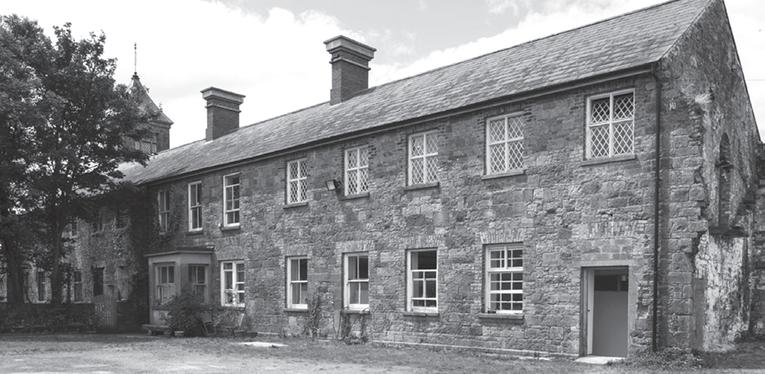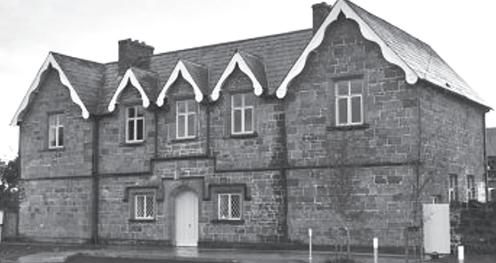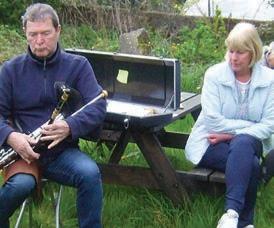
4 minute read
Callan Workhouse: Monument to a dark past…
grated to escape death and oppression.
Part one
Advertisement
BY JOHN FITZGERALD
A building that witnessed the most traumatic events in Irish history has become a cherished heritage asset.
Callan Workhouse is one of the few such structures left standing in Ireland. A monument to the horrors of famine, parts of it have been restored to serve as the local County Council o ce and a centre for artistic endeavour. Behind its historic walls painters, designers, and dramatists are busily engaged; working day and night on assignments that have helped to make the town a cultural Mecca, transforming the social landscape with their critically acclaimed projects.
e Workhouse had an altogether di erent role when Ireland was devastated by the failure of the potato crop in the 1840s. It was chronically overcrowded as thousands of people in the area died of hunger and many more emi- e restoration of the administrative section-or Master’s Block-of the Workhouse was hailed nationally as a remarkable achievement. It was saved from possible dereliction and abandonment thanks to a mix of “people power” and an e ective inter-agency approach to the challenge. e restoration followed years of lobbying by Callan Heritage Society and local councillors. e whole community celebrated when the County Council agreed to base its new o ce for the Callan electoral area in the Master’s Block. e work on the Master’s Block alone would have been a signi cant breakthrough in its own right, but the remaining sections of the Workhouse also received attention. A stake-holding group comprising Camphill Community, which caters for people with special needs, Kilkenny County Council, the South Eastern Health Board, and Callan Heritage Society saw to it that the remaining buildings were preserved and, in some instances, adapted for artistic or community-based purposes. e alliance aimed to develop the Workhouse in a tasteful and yet adventurous way, envisaging, in the words of historian Philip Lynch, a “radical, imaginative, daring initiative, but one very much in keeping with the historical and architectural value of the buildings.” e Callan Workhouse is one of only seventeen still standing in Ireland. And the restored Master’s block is one of ve remaining on this island. While other workhouses yielded to so-called “progress” and consumerism, Callan was fortunate in having a dedicated band of people looking out for its heritage.

For the Master’s Block, a delicate balance was achieved in the restoration project, and an element of contemporary design applied only to the building’s interior. is blended soothingly with the existing structures.
Last month, the Kilkenny Heritage Walking Group arrived to explore the origins and legacy of the Workhouse.
Speakers Marianne Kelly and Paddy Neary took us back to the bad old days, recounting a part of our history that must never be forgotten. Local musician, Mick Dawson, played a lament on the bagpipes before the group set o to Cherry eld, a site inextricably linked to the Workhouse story.


Paddy and Marianne were joined by historian Joe Kennedy and the assembled walkers listened spellbound to a sad tale of that “Other Ireland.” ey were ordered to dig holes and ll them in again, or to build stonewalls in remote areas where nobody wanted walls. Many men died performing this soul-destroying labour. eir wives and children would then be carted o to the Workhouse….
We heard of entire families dropping dead on the roadside or in their makeshift cabins from malnutrition. In Callan and the surrounding countryside, sadistic work schemes added to the misery. Cadaverous, half-starved men were forced to work just to keep themselves and their families alive.
To be continued… at seismic shift could have major implications for human health, and speci cally the spread of disease. El Niño will increase temperatures and make precipitation more volatile, which in turn could fuel the spread of pathogencarrying mosquitoes, bacteria, and toxic algae. It’s a preview of the ways climate change will in uence the spread of infectious diseases.
La Niña is an oceanic phenomenon that results in below-average sea-surface temperatures in the central and eastern tropical Paci c Ocean, and lower average temperatures worldwide. La Niña has dominated Earth’s weather for the past three years. But now forecasters are predicting that, sometime between this summer and the end of the year, La Niña’s opposite extreme, El Niño, will take over.

“ e bottom line here is that there are a range of di erent health e ects that might occur in the setting of an El Niño,”
Neil Vora, a physician with the environmental nonpro t Conservation International, told Grist.org, a non-pro t, independent media outlet dedicated to stories about climate change. “ at means we have to monitor the situation closely and prepare ourselves.”
As with La Niña, the effects of an El Niño extend far beyond a patch of aboveaverage warmth in the Paci c. Parched regions of the world — like Chile, Peru, Mexico and the American Southwest — are often bombarded with rain and snow. Some other parts of the world, including the Northeastern U.S., the Amazon and Southeast Asia’s tropical regions, on the other hand, don’t see much rain at all in an El Niño year. e planet could temporarily become 1.5 degrees Celsius (2.7 degrees Fahrenheit) warmer, on average, than in preindustrial times — a threshold scientists have long warned e link between poor sleep and worsening disease is one that researchers into Alzheimer’s disease are exploring in depth, with a new study nding that using sleeping pills to get some shut-eye could reduce the build-up of toxic clumps of proteins in uid that washes the brain clean every night. ough only short and involving a small group of healthy adults, the study is an interesting demonstration of the link between sleep and the molecular markers of Alzheimer’s disease.
Researchers from Washington University in St. Louis found people who took suvorexant, a common treatment for insomnia, for two nights at a sleep clinic experienced a slight drop in two proteins, amyloid-beta and tau, that pile up in Alzheimer’s disease.
Sleep disturbances can be an early warning sign of Alzheimer’s disease that










